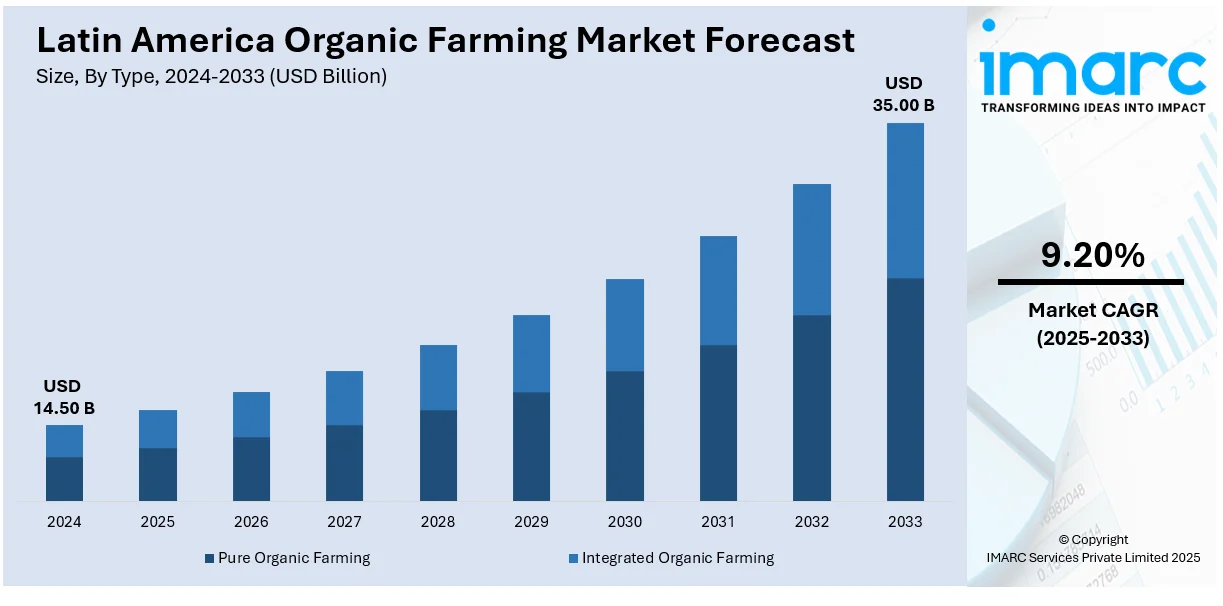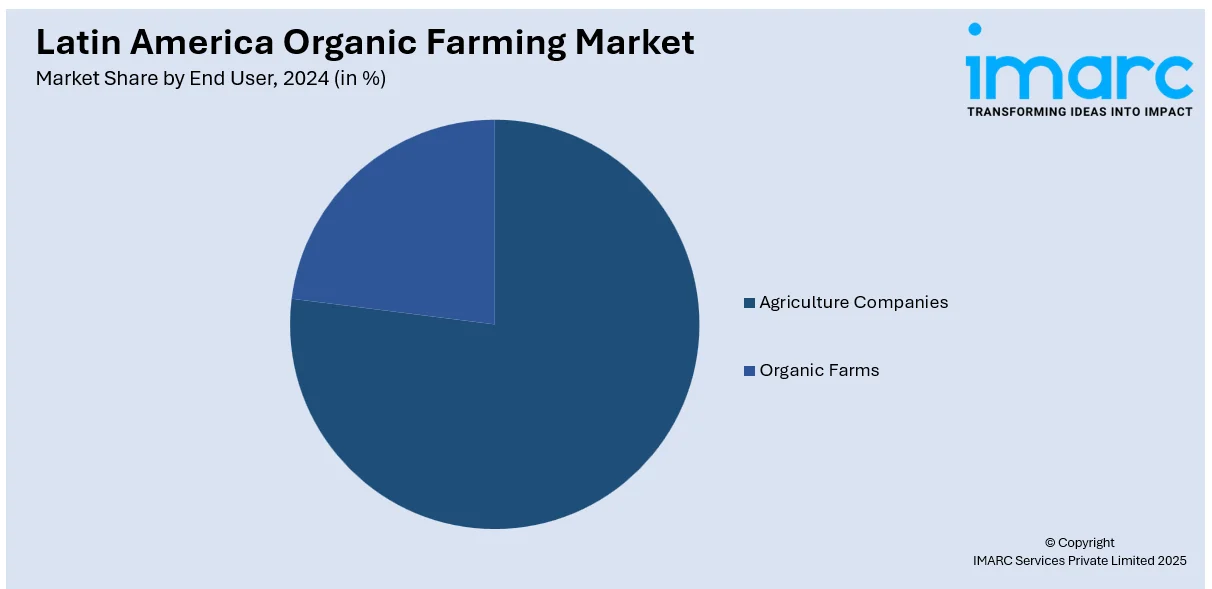
Latin America Organic Farming Market Size, Share, Trends and Forecast by Type, Product, Method, End User, and Region, 2025-2033
Latin America Organic Farming Market Overview:
The Latin America organic farming market size reached USD 14.50 Billion in 2024. Looking forward, IMARC Group expects the market to reach USD 35.00 Billion by 2033, exhibiting a growth rate (CAGR) of 9.20% during 2025-2033. The market is driven by the growing need for organically grown medicinal plants, such as aloe vera, echinacea, and chamomile, along with rising concerns among the masses about the environmental consequences of conventional farming in the region.
|
Report Attribute
|
Key Statistics
|
|---|---|
|
Base Year
|
2024 |
|
Forecast Years
|
2025-2033
|
|
Historical Years
|
2019-2024
|
| Market Size in 2024 | USD 14.50 Billion |
| Market Forecast in 2033 | USD 35.00 Billion |
| Market Growth Rate 2025-2033 | 9.20% |
Latin America Organic Farming Market Trends:
Growing demand for herbal supplements
The IMARC Group’s report shows that the Latin America herbal supplements market reached US$ 3.1 Billion in 2023. As the demand for herbal supplements is growing, the need for organically grown medicinal plants, such as aloe vera, echinacea, and chamomile, is rising. Organic farming practices are often needed to yield high-quality herbal ingredients without the use of synthetic pesticides and chemicals. The herbal supplement industry likes organic raw material, which may motivate farmers to use organic farm practices. Cultivation of herbs such as ginseng, turmeric, and valerian root for supplements might create a change in crop selection in Latin American nations. Latin America is a major agricultural exporter, and the global herbal supplement industry is rapidly emerging, especially in North America and Europe. This desire for organic herbal ingredients for supplements may inspire Latin American farmers to adopt organic farming practices to meet export standards. The increased awareness about the health advantages of herbal supplements, along with a preference for organically derived products, is creating the need for organic farming. Consumers are preferring supplements free of toxins, synthetic ingredients, and GMOs, which is driving organic herb production.

Increasing demand for organic products
As Latin American people are becoming more health-conscious, there is a rise in the demand for organic products free of synthetic chemicals, pesticides, and genetically modified organisms (GMOs). Organic foods are regarded to be safer and healthier, which is driving the demand and encourages farmers to embrace organic agricultural practices for supplying this rising market. Consumers are increasingly concerned about the environmental consequences of conventional farming, which frequently results in soil degradation, water contamination, and biodiversity loss. Organic farming is regarded as a more sustainable choice that improves soil health, lowers chemical runoff, and protects biodiversity. This awareness is catalyzing the demand for organic products, resulting in the rise of organic farms. The desire for organic food goes beyond fruits and vegetables, with development noted in dairy, grains, meat, and processed organic items. This increased demand for organic products promotes a wider range of farmers for switching to organic farming in a variety of agricultural sectors, resulting in market expansion. The growing middle class in nations, such as Brazil, Mexico, and Argentina, is resulting in better disposable incomes, allowing more people to acquire premium organic products. As per the IMARC Group’s report, the Brazil organic food market is expected to reach US$ 13.8 Billion by 2032.
Latin America Organic Farming Market Segmentation:
IMARC Group provides an analysis of the key trends in each segment of the market, along with forecasts at the country level for 2025-2033. Our report has categorized the market based on type, product, method and end user.
Type Insights:
- Pure Organic Farming
- Integrated Organic Farming
The report has provided a detailed breakup and analysis of the market based on the type. This includes pure organic farming and integrated organic farming.
Product Insights:
- Fruits
- Vegetables
- Cereals and Grains
- Others
A detailed breakup and analysis of the market based on the product have also been provided in the report. This includes fruits, vegetables, cereals and grains, and others.
Method Insights:
- Crop Rotation
- Polyculture
- Mulching
- Soil Management
- Weed Management
- Composting
- Others
The report has provided a detailed breakup and analysis of the market based on the method. This includes crop rotation, polyculture, mulching, soil management, weed management, composting, and others.
End User Insights:

- Agriculture Companies
- Organic Farms
A detailed breakup and analysis of the market based on the end user have also been provided in the report. This includes agriculture companies and organic farms.
Regional Insights:
- Brazil
- Mexico
- Argentina
- Colombia
- Chile
- Peru
- Others
The report has also provided a comprehensive analysis of all the major regional markets, which include Brazil, Mexico, Argentina, Colombia, Chile, Peru, and others.
Competitive Landscape:
The market research report has also provided a comprehensive analysis of the competitive landscape. Competitive analysis such as market structure, key player positioning, top winning strategies, competitive dashboard, and company evaluation quadrant has been covered in the report. Also, detailed profiles of all major companies have been provided.
Latin America Organic Farming Market News:
- In November 2023, ADM, a notable player in sustainable agriculture supply chains, announced an important expansion of its global regenerative agriculture efforts with the launch of its program in Brazil to promote and support sustainable agricultural production with a focus on soil health, biodiversity protection, improved soil fertility and resilience, and increased farm productivity.
- In September 2024, Staphyt, which features the Bio-team, a multidisciplinary group of experts specializing in developing biological products, including biopesticides, biostimulants, and biofertilizers, started biological product registration in Brazil and Europe to expand organic farming.
Latin America Organic Farming Market Report Coverage:
| Report Features | Details |
|---|---|
| Base Year of the Analysis | 2024 |
| Historical Period | 2019-2024 |
| Forecast Period | 2025-2033 |
| Units | Billion USD |
| Scope of the Report |
Exploration of Historical Trends,Market Outlook, Industry Catalysts, Challenges, Segment-Wise Historical, Future Market Assessment:
|
| Types Covered | Pure Organic Farming, Integrated Organic Farming |
| Products Covered | Fruits, Vegetables, Cereals, Grains, Others |
| Methods Covered | Crop Rotation, Polyculture, Mulching, Soil Management, Weed Management, Composting, Others |
| End Users Covered | Agriculture Companies, Organic Farms |
| Regions Covered | Brazil, Mexico, Argentina, Colombia, Chile, Peru, Others |
| Customization Scope | 10% Free Customization |
| Post-Sale Analyst Support | 10-12 Weeks |
| Delivery Format | PDF, Excel through Email (We can also provide the editable version of the report in PPT/Word format on special request) |
Key Questions Answered in This Report:
- How has the Latin America organic farming market performed so far and how will it perform in the coming years?
- What is the breakup of the Latin America organic farming market on the basis of type?
- What is the breakup of the Latin America organic farming market on the basis of product?
- What is the breakup of the Latin America organic farming market on the basis of method?
- What is the breakup of the Latin America organic farming market on the basis of end user?
- What is the breakup of the Latin America organic farming market on the basis of region?
- What are the various stages in the value chain of the Latin America organic farming market?
- What are the key driving factors and challenges in the Latin America organic farming market?
- What is the structure of the Latin America organic farming market and who are the key players?
- What is the degree of competition in the Latin America organic farming market?
Key Benefits for Stakeholders:
- IMARC’s industry report offers a comprehensive quantitative analysis of various market segments, historical and current market trends, market forecasts, and dynamics of the Latin America organic farming market from 2019-2033.
- The research report provides the latest information on the market drivers, challenges, and opportunities in the Latin America organic farming market.
- Porter's five forces analysis assist stakeholders in assessing the impact of new entrants, competitive rivalry, supplier power, buyer power, and the threat of substitution. It helps stakeholders to analyze the level of competition within the Latin America organic farming industry and its attractiveness.
- Competitive landscape allows stakeholders to understand their competitive environment and provides an insight into the current positions of key players in the market.
Need more help?
- Speak to our experienced analysts for insights on the current market scenarios.
- Include additional segments and countries to customize the report as per your requirement.
- Gain an unparalleled competitive advantage in your domain by understanding how to utilize the report and positively impacting your operations and revenue.
- For further assistance, please connect with our analysts.
 Inquire Before Buying
Inquire Before Buying
 Speak to an Analyst
Speak to an Analyst
 Request Brochure
Request Brochure
 Request Customization
Request Customization




.webp)




.webp)












